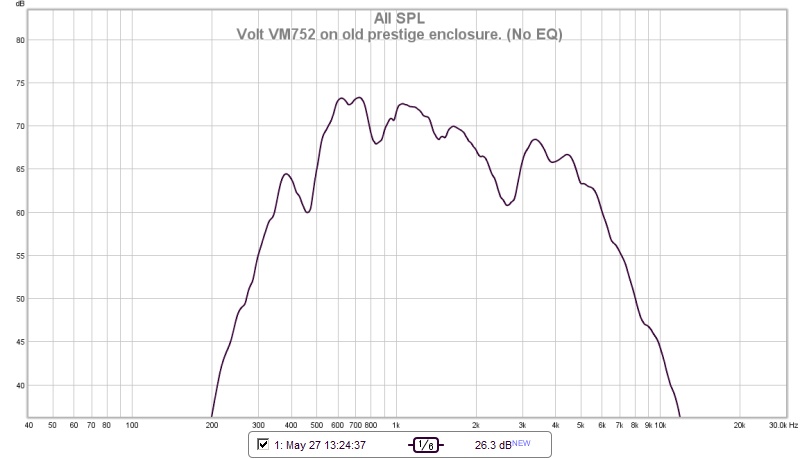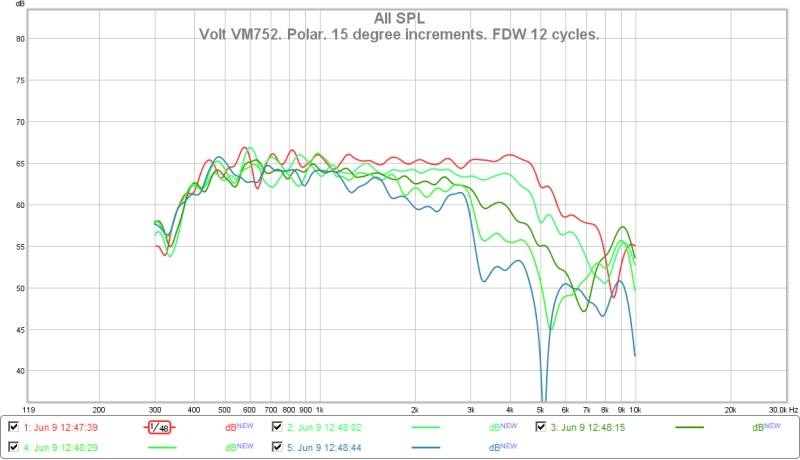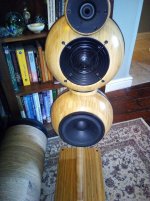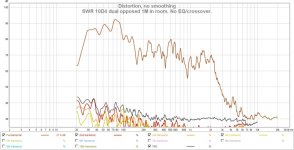Of course I will, when I get to it 🙂 I built a speaker with MarkAudio full range and Blanda bowl 3 years back, it was fun to work the the bamboo.
Anyhow, what kind of crossovers have you planned for the drivers? Are you going to go with digital crossovers or analogue ones? I am thinking if I plan a similar built I'll cross the 90dB sensitive woofer at baffle step to the 86,5dB sensitive midrange for 3,5dB baffle step correction. Have you considered using a Harsch XO for the speakers? It would be easy to account for the delays with physical offset between the spheres when building the speakers.
I prefer active crossovers and have all the amps and both analogue and digital types. Currently contrary to some people's views, I believe minidsp is one of the best sounding options. I use both the 4x10 HD and open DRC DA8 on other systems (I have quite a few builds 😀).
I have used the Harsch crossover slopes extensively in the past and even on the original prestige speakers, so I almost certainly will give it a try over the next few weeks!
Will update how I get on.
I built some full range speakers with IKEA kitchen bowls and Mark Audio drivers too first and was impressed then with the blanda bamboo bowls.
Just thought I would share an idea I had for protecting the volt domes. It is actually a PC fan guard from amazon. Fits quite well
That's awesome, looks like it was made for that use case!
Congrats on a damn fine project, I really like the look. Cheers to you for bringing it all together so well.
That's awesome, looks like it was made for that use case!
Congrats on a damn fine project, I really like the look. Cheers to you for bringing it all together so well.
Thanks so much! Means a lot after all the work 🙂
Bushmeister, since you seem to be the Sorbothane expert at the forums, what do you think of using Sorbothane gaskets between driver and enclosure (driver in question is ScanSpeak 10F/8424)? I was thinking of isolating the driver from the cabinet with a gasket between the driver and the enclosure. Additionally I'll use bolts to connect the driver to the back of the cutout, where there will be more Sorbothane to completely isolate the driver. So the driver will not directly touch the enclosure AT ALL.
Lol!Bushmeister, since you seem to be the Sorbothane expert at the forums, what do you think of using Sorbothane gaskets between driver and enclosure (driver in question is ScanSpeak 10F/8424)? I was thinking of isolating the driver from the cabinet with a gasket between the driver and the enclosure. Additionally I'll use bolts to connect the driver to the back of the cutout, where there will be more Sorbothane to completely isolate the driver. So the driver will not directly touch the enclosure AT ALL.
Thanks for your kind words. I'm hardly an expert on anything. I have used sorbothane quite a bit though.
I have found driver isolation to be very effective, particularly if the box is prone to modal behavior. Gasket and screw isolation is best so you don't mechanically short circuit over the bolt/screw.
Torque then becomes an issue and depending on the shore factor of your sorbothane and thickness, may require experimentation.
If you do not have means to measure cabinet vibration, a stethoscope can be surprisingly revealing.
Mechanical decoupling of driver from box is an excellent way of reducing energy transfer to the cabinet, which unfortunately tends to be re-radiated as cabinet noise or 'box colouration'.
CLD box construction works well too - most important being baffle cld. I have also tried cld bracing which works well.
Bracing and cabinet construction techniques aim to reduce the re-radiated energy by dissipating it in the constrained layer/cabinet materials. Mechanical decoupling aims to stop the energy before it enters the cabinet.
This is partly why I have settled on sphere construction for enclosures it handles the energy very well - no panels to vibrate and radiate unwanted sound.
Ok, thanks for the tips! I was thinking of putting the 10F into a 20cm diameter sphere, same IKEA bowls.
I don't understand this bit. So you think just screw through gasket to the enclosure is better than my full isolation?Gasket and screw isolation is best so you don't mechanically short circuit over the bolt/screw.
Ok, thanks for the tips!
I don't understand this bit. So you think just screw through gasket to the enclosure is better than my full isolation?
No sorry, I was agreeing with your plan. The short circuit happens when people forget to isolate the screw or bolt. As the mechanical energy is then transmitted through the rigid steel bolt/screw
Just like building a sound proof wall. You build a wall off set from another wall creating a gap. If you were to screw or bolt across that gap you lose the isolation.
Hope this is clearer.
Yes, thanks for the clarification. I'll stop hijacking your thread now, time to create my own planning thread soon. As a sneak peak the plan is a Ripole subwoofer up to 250Hz and 10F up from there 🙂
Yes, thanks for the clarification. I'll stop hijacking your thread now, time to create my own planning thread soon. As a sneak peak the plan is a Ripole subwoofer up to 250Hz and 10F up from there 🙂
No worries! That sounds awesome! So many speakers to build and so little time! I will follow it with great interest. 🙂
Just realised that I never showed distortion or freq response measurements of the dual opposed sub design.
If any one is interested in doing a similar build it really is very easy as build go - big piece of PVC pipe, 4 10" alpine subs, single MDF partition, some threaded rods and you are good to go.
Very inert enclosure, excellent mechanical energy cancellation, and the SWR alpine subs are really fantastic.
This is a 1M in room measurement with no EQ or crossover of one sub, just to give an idea how high they can go and what they look like without EQ.
They can go stupidly loud but everything in the room rattles, so distortion measurements become obsolete.
If people want a compact, sealed, high quality sub for not much money - this IMHO is the way to go.
Cheers.
If any one is interested in doing a similar build it really is very easy as build go - big piece of PVC pipe, 4 10" alpine subs, single MDF partition, some threaded rods and you are good to go.
Very inert enclosure, excellent mechanical energy cancellation, and the SWR alpine subs are really fantastic.
This is a 1M in room measurement with no EQ or crossover of one sub, just to give an idea how high they can go and what they look like without EQ.
They can go stupidly loud but everything in the room rattles, so distortion measurements become obsolete.
If people want a compact, sealed, high quality sub for not much money - this IMHO is the way to go.
Cheers.
Attachments
Truly awesome project, your ingenuity and thoroughness is remarkable! If I ever find myself in your corner of the world, I'd be compelled to look you up and beg a listen. ����
Just a couple minor points -- visually, the rectangular base of the stand contrasts with the spheres. A circular base would be more consistent. 😉
And of course an integrated spherical or tubular bass box might have looked too much like a snowman. 😀
And of course an integrated spherical or tubular bass box might have looked too much like a snowman. 😀
Just a couple minor points -- visually, the rectangular base of the stand contrasts with the spheres. A circular base would be more consistent. 😉
And of course an integrated spherical or tubular bass box might have looked too much like a snowman. 😀
Thanks so much for your encouragement - I still spend hours listening to them every week and have not heard anything I have made or others have that comes close.
I like your idea of a circular/oval base though.....I may have to break out my jigsaw and make some adjustments!
Quite agree with you regarding the snowman - my friends refer to them as 'The BB-8s' as it is........ :-D
Since this thread has returned I hate to give a negative thing, but I see some off axis ripple at 3khz that likely is diffraction. Spheres are great but with the volt mid, you've actually made a worst case scenario- a circular edge. It doesn't look like it's hurting things much based on your polars, but it does rather defeat the performance purpose of spheres.
Sorry to buzzkill things! It does look great visually, I'm sure it sounds awesome, as I said, the performance doesn't show that much from the ripple, but it's definitely got some midrange diffraction going on.
Sorry to buzzkill things! It does look great visually, I'm sure it sounds awesome, as I said, the performance doesn't show that much from the ripple, but it's definitely got some midrange diffraction going on.
... I see some off axis ripple at 3khz that likely is diffraction. Spheres are great but with the volt mid, you've actually made a worst case scenario- a circular edge. It doesn't look like it's hurting things much based on your polars, but it does rather defeat the performance purpose of spheres.
Sorry to buzzkill things! It does look great visually, I'm sure it sounds awesome, as I said, the performance doesn't show that much from the ripple, but it's definitely got some midrange diffraction going on.
IMHO, it's hardly a buzzkill, as most of the measured data look fine.
So if a circular/spherical baffle causes symmetrical diffraction for the mid dome, what do you suggest as ideal? Something less symmetrical, I suppose...?
No probs at all badman. I believe the ripple you see though is actually not the baffle at all but the horn of the mid - it is actually much improved from the typical flat rectangular baffles I had it mounted on previously! (This project is a reuse of the drivers from an earlier speaker build!)
Unfortunately no way to avoid the horn lip diffraction.
Unfortunately no way to avoid the horn lip diffraction.
Should also say badman one point you are wrong about - There is no 'circular edge' you are thinking of a disc. A sphere has no edge!
As I am sure you know a disc is very different from a sphere when diffraction is considered.
As I am sure you know a disc is very different from a sphere when diffraction is considered.
Last edited:
Just a reminder for all. The sharp circular edge of a disc/cylinder (worst case for diffraction) versus a sphere (best for diffraction). Easy to think the two would be similar at first glance.
Traditional boxes tend to be somewhere in the middle and software like 'The edge' can be very useful to find the best compromises on baffle dimensions and driver placement.
Traditional boxes tend to be somewhere in the middle and software like 'The edge' can be very useful to find the best compromises on baffle dimensions and driver placement.
Attachments
Last edited:
Re-reading your post Badman - I think you may be referring to the transition from the horn lip to the sphere? Rather than a circular baffle edge as such - my apologies if I misread you initially!
Of course that lip is present even if the VM752 is mounted on a flat baffle, and interestingly as I said earlier the spherical enclosure mitigates the diffraction artifacts compared to a flat baffle. This measurement on a flat baffle shows the extent of the diffraction dip from the horn lip at approx 2.6kHz.

Obviously if you try to eq this 8dB dip on axis, it creates havoc off axis (I have some polars from my old speakers somewhere that illustrate this).
But the new spherical enclose allow EQ on axis to almost a flat FR without the craziness off-axis (10dB swings if I remember right!). As you can see from my polars there really isn't any issues until you get to approx >45 degree off axis, and even then it is only a few dB:

So whilst you are right - there is evidence of diffraction, it really is much better than the alternatives in my experience.
As a final point - I cross at ~2800hz LR4 anyway, so things are starting to rolloff there making it all the more academic!
Of course that lip is present even if the VM752 is mounted on a flat baffle, and interestingly as I said earlier the spherical enclosure mitigates the diffraction artifacts compared to a flat baffle. This measurement on a flat baffle shows the extent of the diffraction dip from the horn lip at approx 2.6kHz.
Obviously if you try to eq this 8dB dip on axis, it creates havoc off axis (I have some polars from my old speakers somewhere that illustrate this).
But the new spherical enclose allow EQ on axis to almost a flat FR without the craziness off-axis (10dB swings if I remember right!). As you can see from my polars there really isn't any issues until you get to approx >45 degree off axis, and even then it is only a few dB:

So whilst you are right - there is evidence of diffraction, it really is much better than the alternatives in my experience.
As a final point - I cross at ~2800hz LR4 anyway, so things are starting to rolloff there making it all the more academic!
- Status
- Not open for further replies.
- Home
- Loudspeakers
- Multi-Way
- Great Balls of Prestige



